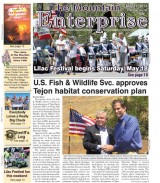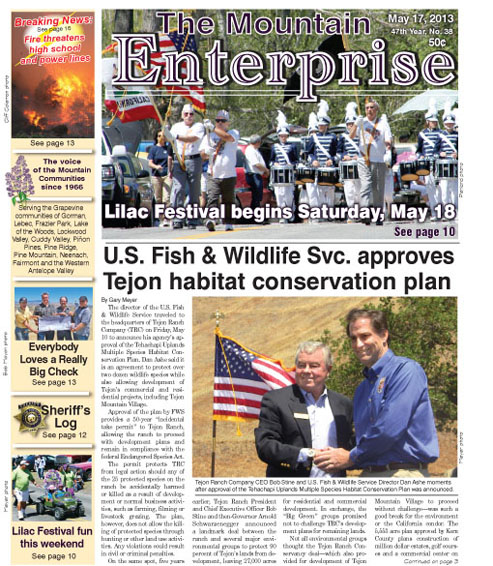![Tejon Ranch Company CEO Bob Stine and U.S. Fish & Wildlife Service Director Dan Ashe moments after approval of the Tehachapi Uplands Multiple Species Habitat Conservation Plan was announced. [Meyer photo]](https://mountainenterprise.com/wp-content/uploads/E-01-Tejon-375x256.jpg)
Image 1 of 2
Tejon Ranch Company CEO Bob Stine and U.S. Fish & Wildlife Service Director Dan Ashe moments after approval of the Tehachapi Uplands Multiple Species Habitat Conservation Plan was announced. [Meyer photo]![The endangered California condor’s core habitat on Tejon Ranch will be changing, USFWS said. [Rick Throckmorton photo]](https://mountainenterprise.com/wp-content/uploads/E-03-Condor-RickThrockmorton.jpg)
Image 2 of 2
The endangered California condor’s core habitat on Tejon Ranch will be changing, USFWS said. [Rick Throckmorton photo]
By Gary Meyer
The director of the U.S. Fish & Wildlife Service traveled to the headquarters of Tejon Ranch Company (TRC) on Friday, May 10 to announce his agency’s approval of the Tehachapi Uplands Multiple Species Habitat Conservation Plan. Dan Ashe said it is an agreement to protect over two dozen wildlife species while also allowing development of Tejon’s commercial and residential projects, including Tejon Mountain Village.
Approval of the plan by FWS provides a 50-year “incidental take permit” to Tejon Ranch, allowing the ranch to proceed with development plans and remain in compliance with the federal Endangered Species Act.
The permit protects TRC from legal action should any of the 25 protected species on the ranch be “harassed” as a result of development or normal business activities, such as farming, filming or livestock grazing. The plan, however, does not allow the lethal take, “killing” of protected California Condor through hunting or other land use activities. Any violations could result in civil or criminal penalties.
On the same spot, five years earlier, Tejon Ranch President and Chief Executive Officer Bob Stine and then-Governor Arnold Schwarzenegger announced a landmark deal between the ranch and several major environmental groups to protect 90 percent of Tejon’s lands from development, leaving 27,000 acres for residential and commercial development. In exchange, the “Big Green” groups promised not to challenge TRC’s development plans for remaining lands.
Not all environmental groups thought the Tejon Ranch Conservancy deal—which also provided for development of Tejon Mountain Village to proceed without challenge—was such a good break for the environment or the California condor. The 5,553 acre plan approved by Kern County plans construction of million dollar estates, golf courses and a commercial center on sensitive areas of the ranch prompted Arizona-based Center for Biological Diversity (CBD) to sue Kern County, Tejon Ranch Company and its development partner DMB Associates in 2009, claiming that the environmental impact study, public notice and subsequent report were inadequate.
Kern County Superior Court Judge Kenneth Twisselman ruled against CBD, clearing the way for Tejon Ranch to move ahead with its development plans.
During Friday’s press conference, U.S. Fish and Wildlife Service Director Dan Ashe said, “The plan we celebrate today is the result of many people thinking big ideas about wildlife conservation. It is a landmark plan with a landscape view of conservation, and helps ensure California condors, birds and other rare wildlife will remain a vital part of this landscape for years to come.”
CBD attorney Adam Keats disagreed. He is quoted as saying of the USFWS approval: “This is not a habitat conservation plan, it is a habitat destruction plan.”
CEO Bob Stine, who also announced his retirement during the past week, said, “The multiple-year process was both a challenge and a journey for all parties involved, but it was a journey worth taking. The end result is an incredible success story for the [Habitat Conservation Plan] process, with the signing of this permit covering nearly 142,000 acres of incredible California landscape and protecting not only the California condor, but 24 additional species as well.”
After the housing market collapse, the snail’s-pace economic recovery has moved slowly, benefitting developers over the last two years. Stine has kept pace, leading his team on a steady march to full entitlement for Tejon Mountain Village, deflecting challenges along the way.
The timing appears to have worked out perfectly for the Wall Street-owned Tejon Ranch Company, assuming that further lawsuits or appeals are not hidden amongst the tumbleweeds, and assuming that banks will eventually go back into the business of lending money—so home buyers can seek to own a piece of the condor’s paradise.
This is part of the May 17, 2013 online edition of The Mountain Enterprise.
Have an opinion on this matter? We'd like to hear from you.


